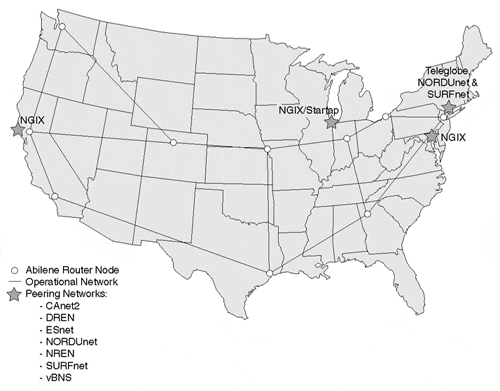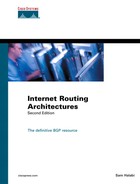The Once and Future Internet
Surprisingly enough, although commercialization of the Internet has resulted in a phenomenal rate of growth over the past 10 years, it hasn't hindered innovation. Instead, it has inspired it. Development of new technologies by the commercial sector, as well as research and educational organizations, is occurring at an astounding rate. New technologies can no longer be immediately deployed in the now "production" Internet; they need to be thoroughly debugged and optimized for realistic conditions. Testbeds were created for early adoption of new technologies.
Next-Generation Internet Initiative
The federally funded Next-Generation Internet (NGI) Initiative[17] is a multiagency U.S. federal research and development program that is developing advanced network technologies and revolutionary applications and demonstrating these capabilities on testbeds that are 100 to 1,000 times faster end-to-end than today's Internet.
The NGI initiative began October 1, 1997, with the following participating agencies:
-
DARPA (Defense Advanced Research Projects Agency)
-
DoE (Department of Energy)
-
NASA (National Aeronautics and Space Administration)
-
NIH (National Institute of Health)
-
NIST (National Institute of Standards and Technology)
-
NSF (National Science Foundation)
The NGI initiative is managed by individual agency program managers and is coordinated by the Large-Scale Networking Working Group of the Subcommittee on Computing, Information, and Communications (CIC) R&D of the White House National Science and Technology Council's Committee on Technology.
NGI goals include the following:
-
Conduct R&D in advanced end-to-end networking technologies
-
Establish and operate two testbeds
-
Conduct R&D in revolutionary applications
Conduct R&D in Advanced End-to-End Networking Technologies
The NGI is fostering early deployment of new technologies that will one day be an integral part of the commercial Internet. These technologies are focused on enhancing many aspects of computer networking, to include the following:
-
Reliability
-
Robustness
-
Security
-
Quality of service/differentiation of service (including multicasting and video)
-
Network management (including allocation and sharing of bandwidth)
Establish and Operate Two Testbeds
Ensuring availability of capable testbeds is key to accomplishing the goals of the NGI. Two testbeds, referred to loosely as the "100x" testbed and the "1000x" testbed, will be developed for this purpose.
The "100x" testbed will connect at least 100 sites—universities, federal research institutions, and other research partners—at speeds 100 times faster end-to-end than today's Internet.
The testbed will be built on the following federal networks:
-
NSF's very high-speed Backbone Network Service (vBNS)
-
NASA's Research and Educational Network (NREN)
-
DoD's Defense Research and Education Network (DREN)
-
DoE's Energy Sciences network (ESnet)
The "1000x" testbed will connect about 10 sites with end-to-end performance at least 1,000 times faster than today's Internet. The "1000x" testbed will be built upon DARPA's SuperNet.
These testbeds will be used for system-scale testing of advanced technologies and services and for developing and testing advanced applications.
Conduct R&D in Revolutionary Applications
NGI research and development will focus on enabling applications and technologies such as these:
-
Collaborative technologies
-
Digital libraries
-
Distributed computing
-
Privacy and security
-
Remote operation and simulation
It will also focus on disciplinary applications such as these:
-
Basic science
-
Crisis management
-
Education
-
The environment
-
Federal information services
-
Health care
-
Manufacturing
Internet2
Internet2[18] is a project of the University Corporation for Advanced Internet Development (UCAID). It was announced in October 1996 by 34 research universities with a mission of helping to sustain U.S. leadership in development, deployment, and operation of next-generation network applications and infrastructure. The primary role of Internet2 is to provide focus on fostering the growth of advanced Internet applications and networking protocols that will strengthen the work of universities in their research and education roles. With the exponential growth of the Internet, commercial networks controlled by service providers are deploying bandwidth and technologies as rapidly as research and education networks. One of the primary goals of Internet2 is to re-create the leading-edge capabilities of testbed networks and then facilitate transfer of these technologies to the global Internet.
Internet2 is now a collaborative effort of more than 160 U.S. universities in partnership with more than 50 major corporations. UCAID's member universities and corporations fund Internet2. Many of the member institutions receive funding through competitively awarded grants from the NSF and other federal agencies participating in the NGI initiative. Funding is also made available through other initiatives such as the NSF's Knowledge and Distributed Intelligence (KDI) program.
Internet2's goal is not to replace the Internet, but rather to enhance it by making available technologies and experiences developed by Internet2 members. Member universities will still require commodity Internet connections from commercial service providers, and utilization of those connections will continue to grow.
Abilene
Abilene[19] is another project of UCAID. It's complementary to Internet2 in the sense that the main goal of Abilene is to provide a primary backbone network for the Internet2 project. UCAID, in partnership with Qwest Communications, Nortel Networks, and Cisco Systems, has developed the Abilene network. Abilene provides the high-performance interconnect services among the Internet2 regional aggregation points. The primarily OC48c (2.5 Gbps) POS (Packet Over SONET) Abilene network became operational in January 1999 and provides OC3 and OC12 access services.
Much like the vBNS, Abilene will continually explore emerging Internet technologies, but because of the importance of network stability, Abilene will develop a separate high-performance test network for support of applications that cannot yet be deployed on the leading-edge-but-stable Abilene network. Internet2 working groups are in the process of hashing out Abilene deployment details, focusing on native multicast services, optimizing routing configurations and policies, IPv6, and QoS. Abilene provides native multicast services and is planning deployment of IPv6 and QoS.
Figure 1-8 represents the current Abilene network.
Figure 1-8. Abilene Network: Peering Map

